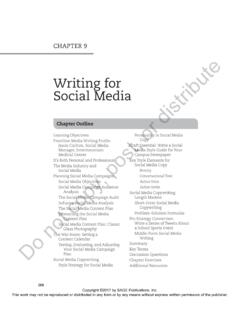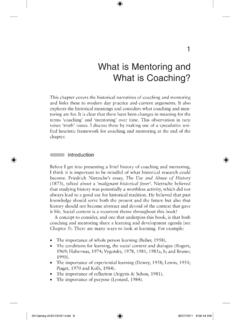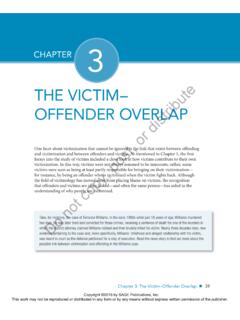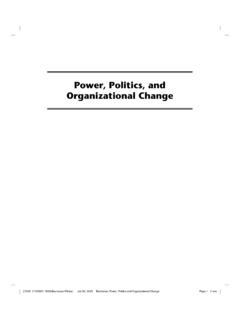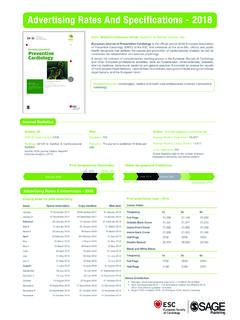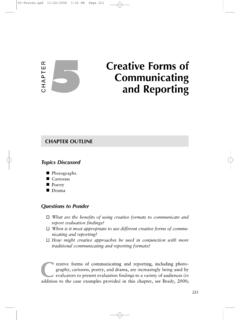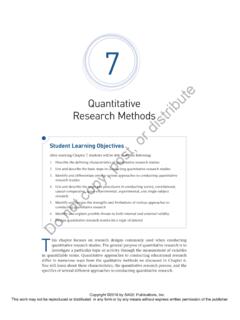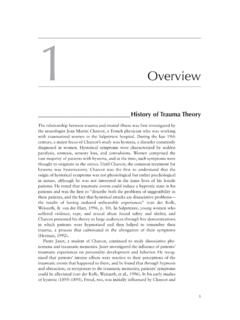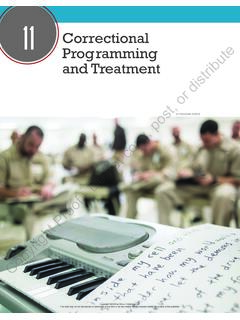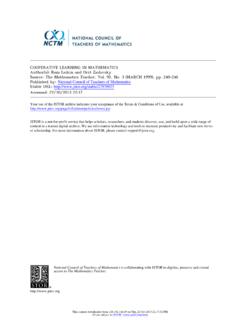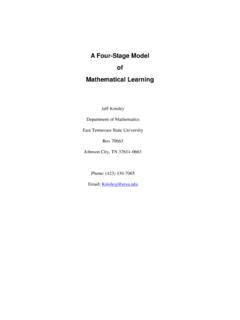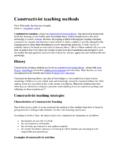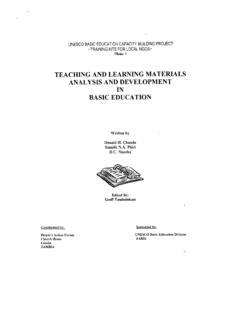Transcription of How Children Learn Mathematics and the …
1 3 How Children Learn Mathematics and the Implications for TeachingHelen Taylor1In this chapter you can read about: Why and how young Children Learn Mathematics The importance of practical activities Starting with Children s interests Children solving problems The progression of Children s mathematical ideas from birth to 8 years nature of Mathematics and young Children learning What do you think Mathematics is? Is it appropriate and important for very young Children ? At what age do you think Children should start learning mathematical ideas? How can adults help? Chapter Overview01-Taylor & 310/21/2013 6:56:14 PM4 learning and teaching Mathematics 0 8 Mathematics is defined as the abstract science of number, quantity and space by The Concise Oxford Dictionary (Allen, 1990: 732). It can be seen as a way of organising ideas in order to develop concepts. Skemp (1971) identified that having a concept involves more than knowing its name; it involves being able to use the understanding developed from recognition of similarities between particular examples of the con-cept.
2 Freudenthal (1973) argued that Children develop concepts as a result of experi-ences and thinking about those experiences. This may seem remote from Children aged from birth to 8, however babies and young Children are naturally curious and explore their world from an early age. They do not compartmentalise their explora-tions as mathematical or otherwise. However, they will encounter mathematical ideas such as number, quantity and shape. Mathematics is an essential area of understand-ing and knowledge in our everyday lives as adults and this is also true for Children . The National Curriculum (DfEE, 1999a: 60) states Mathematics equips pupils with a uniquely powerful set of tools to understand and change the world. These tools include logical reasoning, problem solving skills and the ability to think in abstract ways . Lee (2006) states that Mathematics empowers and enables us to take control of various aspects of our lives.
3 It is also a creative discipline, capable of being used flexibly to communicate precisely. Mathematics can also be seen as a web of ideas that are continually refined and developed. According to ACME (2008: 4) the big ideas of Mathematics for young Children include place value and the number system, conservation of number and measures, equivalence relations and dimensionality (see chapters in Part 2).Parents and carers will often intuitively draw young Children s attention to mathe-matical ideas by pointing out and talking about numbers, quantities, shapes and sizes as part of everyday life. This will be continued when they sing and recite rhymes to, and with, their Children and as they play with their Children using a variety of toys and objects (for example, wooden bricks and other construction toys, soft toys, small-world toys and toy versions of real objects like tea sets). Mathematics features in the routines of everyday life, such as getting dressed and putting on two socks or laying the table and getting three plates out.
4 Children begin to use vocabulary that reflects understanding of Mathematics such as when they ask for more chocolate, sweets or chips. From these early mathematical experiences and ideas, Children will gradually extend their understanding to more formal do young Children Learn Mathematics ?A number of theorists have proposed ideas about how Children Learn generally, and these ideas can be related to the learning of Mathematics . Piaget (in Donaldson, 1978) believed that Children construct their own knowledge and understanding through their interactions with their environment. This is called a constructivist & 410/21/2013 6:56:14 PM How Children Learn Mathematics 5 Vygotsky (in Atherton, 2011) is often referred to as a social constructivist. He emphasised the need for a child to have guidance from a more knowledgeable other and to have opportunities to interact socially with peers as a means of learning . He also proposed the idea of the Zone of Proximal Development , which is that a child can work with someone else to achieve something that they could not achieve on their own, thereby learning through this process so that eventually they are able to perform the task by themselves.
5 This is sometimes called scaffolding (Bruner, 1966; Wood, 1998). Similarly, Gifford (2008) refers to cumulative learning , meaning that learning needs to build on previously learnt ideas and that presenting Children with something too advanced will not be learning is associated with the development of mathematical understanding. Barmby et al. (2009) see this as a continuum where Children add to and refine previous understandings. This builds on the work of Bruner (1966) who identified the idea of the spiral curriculum, where Children meet an idea at one level and then later meet the idea again but are able to study it at a deeper level and achieve a better understanding of it. His influence can be seen in many Mathematics curricula documents and in the practice of teaching Mathematics . Bruner also suggested that Children go through three phases when learning . The enactive phase is when Children engage with something concrete in order to explore and manipulate ideas; this could be related to kinaesthetic learning .
6 The second phase, iconic, is when Children begin representing the ideas in a more abstract way. This can be supported in Mathematics by using models and images so that eventually Children can visualise some of them internally to assist their thinking. Finally, Children come to the symbolic phase where they can use abstract ideas and ways of representing the s (1984) ELPS approach is related to Bruner s enactive, iconic, symbolic phases in some ways. The E stands for Experience Children need practical experi-ence of the ideas to start with. L is for language, and this is where Liebeck s approach differs from Bruner s; Liebeck emphasises the need for Children to Learn the language of Mathematics , highlighting the need for adults and Children to talk about the ideas. She then recommends that Children go on to represent mathematical ideas through pictures (P) or diagrams before moving on to formal recording of Mathematics through the use of symbols (S).
7 Similarly, Gifford (2008) emphasises the importance of multisensory experiences for learning . Froebel (in Beckley, 2011) also emphasised the importance of practical activity for Children s learning , including gardening and use of building blocks. This influence can be clearly seen currently in many nursery settings in the (1971) described two ways of understanding mathematical ideas that he called instrumental and relational understanding . Instrumental understanding is a shallower form of understanding. For example, we might develop an instrumental understanding of how to add, subtract, multiply and divide using a set procedure or 01-Taylor & 510/21/2013 6:56:14 PM6 learning and teaching Mathematics 0 8 CASE STUDY algorithm by memorising the steps required. However, we might not understand how the procedure worked or why the various steps in the procedure are needed. One of the difficulties with this level of understanding is that if our memory of the procedure failed, we would be unable to continue.
8 In contrast, a relational understanding of these procedures would mean that we understand how and why the procedures work. The importance of practical activitiesThe work of Piaget, Bruner and Liebeck all emphasises practical activity as a starting point for learning with young Children and Gifford (2008) reports neuroscientific sup-port for this approach, too. Children are naturally curious and explore the world around them. They love to play. Adults working with young Children can build on this in order to support mathematical development. One way to do this is to ensure that appropriate toys and other resources are available for Children to play with and for the adults to recognise the mathematical potential of these toys and resources. Adults can then observe Children interacting with the resources and provide additional resources or play alongside Children using appropriate vocabulary and asking appro-priate questions to maximise this potential.
9 What sort of toys and resources will be helpful in supporting Children s mathematical development? Do they have to be especially produced for Mathematics ? Which everyday toys that young Children play with might also help to develop mathematical ideas?Farm setOliver, aged 5, and Daniel, aged 3, both had identical new farm sets. They played together creating fields of different sizes and shapes with the eight fence sections. They created various shapes and sizes and arranged animals in the fields talking about how many animals would fit and whether they wanted big or small animals in the various fields. In each set there was a tree and the boys sometimes included the trees as field boundaries to increase the different shapes they could produce. At one point they used a section of fence to create a common boundary between two fields, 01-Taylor & 610/21/2013 6:56:14 PM How Children Learn Mathematics 7leaving two fence sections out.
10 Oliver announced that they had a square field and a triangle field . He went on to talk about the triangle field being smaller than the square field. Then he said that triangles are always smaller than squares . I asked him if this was always true and said I thought I could draw a really big triangle. He rushed off to find pen and paper and drew the largest triangle he could on a sheet of A4 paper, then he cut this out. He then gradually cut into the triangle creating smaller and smaller triangles. He also drew three rectangles, which he called squares on another piece of paper and wrote small to [middle] size to big and told me that he could draw squares in lots of sizes. Taking another piece of paper, he drew a series of five triangles, each one slightly larger than the one before, a similar set of six circles and finally four squares (see Figure ). This demonstrates that he has a good under-standing of ordering sizes and that a shape can come in any size, contradicting his previous statement that triangles are always smaller than squares.
